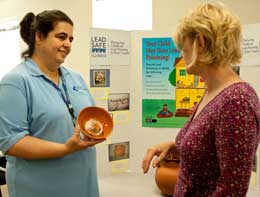Lead poisoning is the most common environmental illness affecting children. While Illinois has made great progress in recent years, we maintain one of the highest rates in the nation for the number of children with elevated blood lead levels. Elevated lead rates are caused primarily from breathing in contaminated dust from old lead-based paint in homes built before 1978. Secondary sources of lead poisoning come from lead in painted toys, cooking with leaded pottery, eating lead-based paint chips, and toys/toy jewelry. There are a number of laws in Illinois to protect residents from lead poisoning.
Lead Poisoning Prevention

Lead-based paint and contaminated dust are the primary sources of lead exposure in U.S. children. Although lead-based paints were banned in 1978, many homes built before then still contain it. The deterioration of this paint creates hazardous dust. About 24 million housing units have deteriorated lead paint, and over 4 million of these homes house young children.
Children under 6 are especially vulnerable due to their rapid growth and tendency to put objects in their mouths, which may carry lead dust. Those at greatest risk are children living at or below the poverty line in older homes. Additionally, some racial and ethnic groups are disproportionately affected.
Under Illinois law, any child residing in a high-risk ZIP code is to be tested automatically at 12, 24, and 36 months. All children six years of age and younger are required to be assessed for lead exposure through the use of a questionnaire administered by a pediatrician. In addition, children who fall into other risk categories spelled out in the questionnaire are also tested.
KCHD Childhood Lead Poisoning Prevention Program
Lead poisoning is entirely preventable by stopping children's exposure to lead and treating those already affected. Parents can reduce exposure by identifying and safely removing lead hazards in the home.
Kane County offers programs to help families with lead-based paint hazards. Homeowners and renters who meet income requirements (e.g., $60,650 for a family of four) are eligible. Work is conducted by lead-licensed contractors based on risk assessments.
The Childhood Lead Poisoning Prevention Program educates families on reducing exposure and securing treatment, while also raising community awareness. Blood lead screenings, available through medical providers, can identify at-risk children for prompt treatment. Homes built before 1978 are especially concerning.
If you are interested in having your home inspected for lead risks, contact a licensed Lead Risk Assessor.
If you have further questions, please email Kane County Health Department at: askus@kanehealth.com
Safe Home Practices
EPA: Learn about Lead
EPA: Renovation, Repair and Painting Program Certified Contractors
EPA: Lead-Safe Renovation Resources for DIYers
EPA: Protect Your Family from Sources of Lead
U.S. Consumer Product Safety Commission Recall List
HUD: Guide to Lead-Safe Housing
Homeowners’ Lead-based Paint Abatement Guide
Contractors working on homes with lead paint are required to follow the EPA’s Lead Renovation, Repair, and Painting (RRP) rule, which provides guidelines for protection against renovation activities that can disturb lead dust such as sanding, cutting and demolition.
Resources
2022 Illinois Lead Program Annual Surveillance Report
Lead-Free Kids Bookmarks - English and Spanish
Lead Risk Assessors in Illinois
CDC: Childhood Lead Poisoning Prevention Program
Webinar: Consequences of Childhood Lead Exposure & Lead Renovation, Repair, and Painting Rules